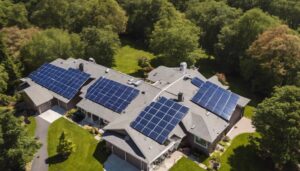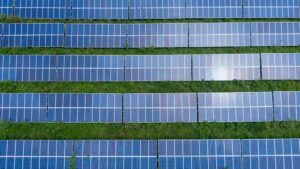Navigating the hidden costs of a solar setup can be like peeling an onion; each layer reveals new expenses that you might not have anticipated. You’re aware that the initial investment can be substantial, but have you considered the full financial landscape that comes with solar panel ownership?
From insurance and maintenance to landscaping and additional utility fees, these expenses can add up. Moreover, the soft costs, often overlooked, such as permit acquisition and sales taxes, play a significant role in the true price of your solar setup.
As you weigh the long-term savings against the upfront costs, it’s crucial to understand how every dollar is allocated. Stay tuned to uncover the less obvious, yet impactful, costs that could influence your decision and the overall sustainability of your solar investment.
Listen To The Summary
Understanding Residential Solar Panel Costs
When you’re eyeing a sun-powered future for your home, it’s essential to grasp the full spectrum of costs that come with residential solar panel installations, beyond just the price of the panels themselves. The average cost of a residential solar setup isn’t just about the hardware; it encompasses a variety of hidden costs that can affect your wallet.
You’ll need to factor in insurance and maintenance to protect your investment and ensure your system’s longevity. If you opt for ground-mounted panels, landscaping and animal control are necessary to prevent shading and damage. Plus, don’t forget the internet costs for system monitoring; they’re crucial for keeping track of your energy production and pinpointing issues from afar.
Even with a solar panel installation cutting down your electric bills, you can’t ignore the unavoidable charges from utility companies. And let’s talk about soft costs. Sales and marketing, labour, permitting, and supply chain expenses significantly inflate the total cost.
Breaking Down the Installation Costs
As you explore the nitty-gritty of installation costs, you’ll find that equipment expenses often make up the bulk of the upfront investment.
Don’t overlook the labour charges, which cover the skilled workmanship required to safely install your panels, and the fees associated with permitting and inspections, ensuring your solar setup meets local regulations.
Understanding these costs can help you budget effectively and avoid surprises during your solar journey.
Itemizing Equipment Expenses
Understanding the costs of your solar setup requires a detailed look at the equipment expenses, which are often the bulk of your investment. The cost of solar panels, the heart of your system, can swing widely based on efficiency and size, influenced by your energy consumption needs.
Inverters, which the Solar Energy Industries Association knows are vital for conversion, might set you back $1,000 to $5,000.
Racking systems, as per watt pricing suggests, add an average of $0.20 to $0.75 per watt to your initial investment.
Don’t forget wiring; it’s not just about panel size but also system complexity, adding a variable cost.
The National Renewable Energy Laboratory emphasizes that a well-sized system maximizes value, so tailor your panel selection to your energy profile to ensure a smart investment.
Labour Charges Overview
Peeling back the layers of your solar installation bill, you’ll find that labour charges, while only constituting 7% of the total cost, are essential for a swift and successful setup. When installing solar panels on your home, professional installers are key to ensuring the solar power system operates efficiently, saving you money on energy and high electricity rates in the long run.
Here’s a quick breakdown of installation labour costs:
|
System Size
|
Labor Cost Estimate
|
|---|---|
|
Small
|
Several hundred
|
|
Medium
|
Low thousand(s)
|
|
Large
|
Several thousand
|
|
Complex Systems
|
Varies
|
Permitting and Inspection Fees
Diving into the nitty-gritty of solar installation costs reveals that permitting and inspection fees, though often overlooked, are imperative to ensure your setup adheres to local standards and regulations. These fees aren’t just red tape; they’re your assurance that the solar system you’re investing in is safe and optimized for electricity production. Charged by local government agencies and the local utility, these fees can vary significantly based on where you live.
When budgeting, remember that these costs are an essential slice of the pie. Your solar provider should help you navigate this process, potentially saving you money and headaches. Financing options may also cover these fees, so you won’t have to pay them out-of-pocket.
In the end, proper permitting and inspections are investments in the longevity and efficiency of your solar panels.
Financing Your Solar Energy
While investing in solar energy can significantly reduce your utility bills, it’s crucial to explore the various financing options available to make this sustainable upgrade more affordable. Financing your solar energy isn’t just about the initial outlay; it’s about understanding how solar panels save you money over time compared to the national average energy costs.
To hook you into the financial side of solar, consider these points:
- Solar Loan: Secure a solar loan, which is specifically designed to fund the purchase and installation of your solar panels, often with favourable terms.
- Tax Credits: Take advantage of federal solar tax credits to lower the cost of your solar system.
- Database of State Incentives: Check out the DSIRE database for state-specific incentives that could further reduce your expenses.
- Net Metering: Understand how net metering policies credit you for the excess power your system generates, offsetting future energy bills.
- Solar Companies: Some solar companies offer leasing or power purchase agreements (PPAs), allowing you to avoid upfront costs.
Maintenance and Operational Costs
When you switch to solar, it’s important to factor in not only the initial investment but also the ongoing maintenance and operational costs that come with your eco-friendly power source. While solar panels are designed to last and typically have a lower upfront cost compared to traditional energy sources, they aren’t entirely free from maintenance costs. Fortunately, these are usually minimal, thanks to robust manufacturers’ warranties that cover most repairs.
However, be aware that certain unavoidable charges persist, such as the customer service and delivery fees on your utility bill. Also, if your home isn’t bathed in sunlight year-round, you might face additional costs for professional cleaning to keep your panels efficient. This can set you back a few hundred to several thousand dollars, depending on your system’s size and location.
Moreover, system monitoring comes into play to ensure your setup runs smoothly. Reliable internet is a must for remote monitoring, adding a typical monthly fee of $50 to $100+. And remember, net metering allows you to earn credits for the excess power you generate, but if your panels fall short, you’ll need to pull from the grid and pay for that usage.
Tax Incentives and Solar Rebates
You’re in for a treat when it comes to the financial perks of solar energy. Understanding the Federal Tax Credit, state-specific incentives, and local rebates can slash your installation costs considerably.
Let’s explore how these benefits can make your switch to solar a savvy financial move.
Federal Tax Credit Overview
Harnessing the sun’s power for your home becomes more affordable with federal tax credits, as these incentives can significantly offset the cost of solar system installation. Dive into the federal tax credit overview to unpack how you can benefit from tax incentives when installing a solar array. With the Department of Energy’s backing and the Solar Energy Industries Association’s guidance, you’re looking at substantial tax breaks that enhance cost and savings.
- Maximize Savings: Secure a 26% tax credit on your total solar system cost.
- Act Now: The credit drops to 22% in 2024 timing is everything.
- Research Pays Off: Understand the intricacies to fully leverage the benefits.
- Consult Experts: A solar company can help navigate complex tax incentives.
- Consider Financing: Look into solar loans that work hand-in-hand with federal incentives.
Stay informed and make your solar investment even smarter.
State-Specific Solar Incentives
Beyond federal support, your state may offer additional tax breaks and rebates that further lower the cost of transitioning to solar power. The Solar Energy Industries Association emphasizes the variety of state-specific solar incentives available.
Depending on where you live, you could enjoy credits on state income taxes or cash rebates for the electricity generated by your panels. Some states even allow you to sell excess energy your system produces back to the grid, offsetting the costs of solar even more.
Local Rebate Opportunities
Digging into local rebate opportunities and tax incentives can significantly reduce the costs of solar panel installation for your home. Considering going solar? Now’s the time to tap into these savings and join the clean energy revolution. By understanding local rebate opportunities, you’re positioning yourself to save significantly on your electric bill.
- Research state and federal tax credits for solar panels—these can cover a substantial portion of your initial investment.
- Compare solar incentive programs from the Solar Energy Industries Association for updates.
- Check for utility company rebates that lessen the amount of electricity costs.
- Consider additional local rebates that may be exclusive to your region.
- Consult experts to maximize your financial benefits and revolutionize the industry for your household.
Calculating Return on Investment
When considering the switch to solar power, it’s crucial to calculate the Return on Investment (ROI) to understand when you’ll start seeing the financial benefits of your solar system. Personal finance decisions, especially ones as big as installing solar panels, should be made with a clear picture of the potential return.
Here’s a simplified example of how to calculate your ROI:
| Factor | Detail | Note |
|---|---|---|
| Initial Investment | Cost of solar system | Includes installation |
| Annual Savings | Reduced electric bill | Cost of the solar system |
| Maintenance Costs | Yearly upkeep | Generally low for solar |
| Incentives | Rebates/Tax Breaks | Vary by location |
| Break-Even Point | Years to recoup cost | Investment divided by savings |
To pinpoint when you’ll break even, subtract any incentives from the actual cost of your solar setup and divide that number by your annual savings on your monthly electric bill. Keep in mind that rates vary by utility companies, and the electricity produced is influenced by factors such as sunlight exposure and system size.
This will give you a personalized return on investment timeline, helping you to make an educated decision about this green power source.
Frequently Asked Questions
What Is the Truth Behind No Cost Solar Panels?
You’ve heard solar myths about ‘no-cost’ panels but beware of hidden fees and marketing gimmicks. Understand ownership options, and contract terms, and factor in maintenance expenses, technology upgrades, and incentive eligibility for true environmental impact.
What Costs Would Be Involved in Solar Panels?
Your solar panel costs include initial investment, installation fees, and maintenance costs. Panel efficiency, energy rates, system size, and roof suitability affect expenses, while government incentives and warranty coverage can help offset them. Weather impacts longevity.
Are Solar Panels Worth the Expense?
You’ll find solar panels pay off through energy independence, resale value, and environmental impact. Consider solar incentives, panel efficiency, and market trends. A break-even analysis will clarify costs against maintenance fees and installation challenges.
Do You Save Money With Solar Panels?
You’ll save money with solar panels through tax breaks, increased resale value, and energy independence. Financial incentives and feed-in tariffs boost savings, offsetting maintenance expenses and making your renewable investment worth it over the panel lifespan.
Conclusion
In conclusion, the cost of residential solar panels goes beyond just the price of the panels themselves. Insurance, maintenance, landscaping, internet costs, and additional utility fees are all factors that contribute to the overall cost. Soft costs such as permit acquisition and sales taxes also play a significant role.
Understanding these costs can help you make an informed decision about switching to solar energy and ensure the sustainability of your investment. With proper planning and financing options, you can enjoy the long-term savings and benefits of solar energy while minimizing upfront costs.



